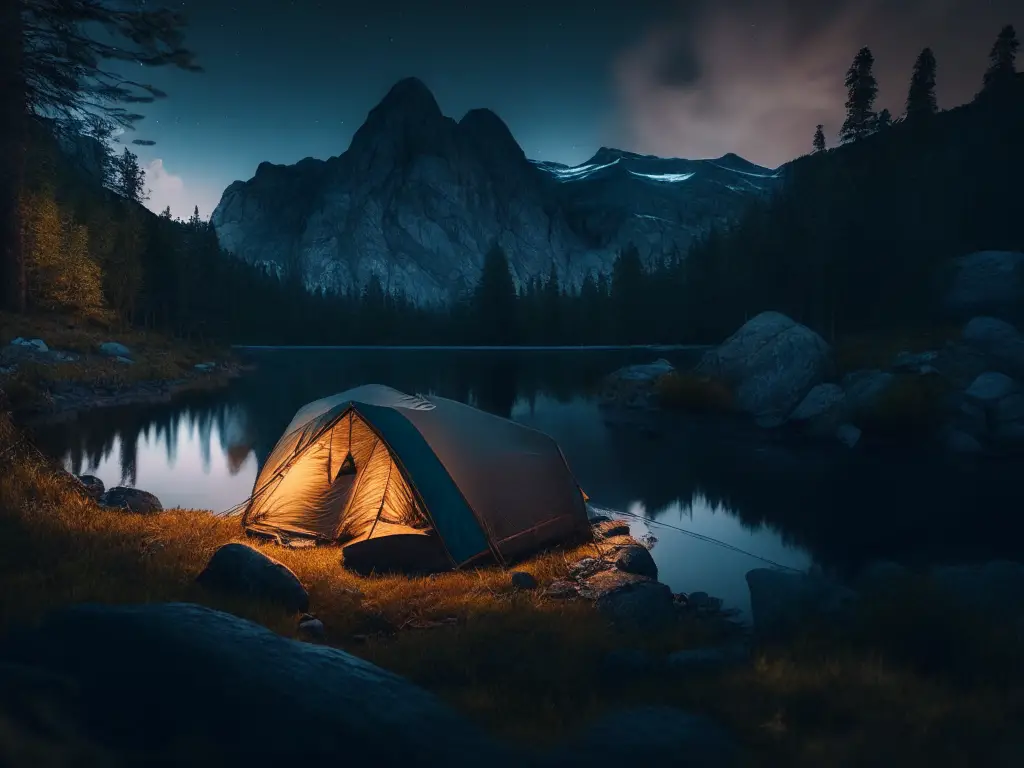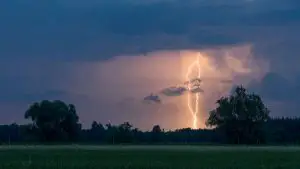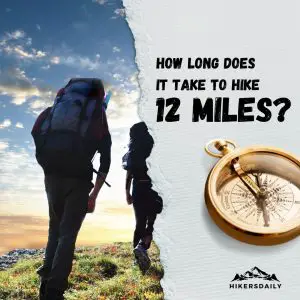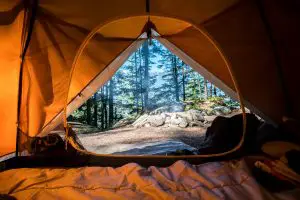Can You Camp in National Parks? Everything You Need to Know

Can you camp in national parks? When most people think of national parks, they think hiking, waterfalls, and beautiful scenery. But guess what – you can go camping in pretty much all national parks!
So in this article, we’ll explore the rules and regulations surrounding camping in national parks, including permits, designated campsites, and safety guidelines. Whether you’re planning a weekend getaway or a longer adventure, read on to discover everything you need to know about camping in national parks.
Quick Links
Benefits of Camping in National Parks
Camping in national parks offers a unique opportunity to connect with nature and enjoy the great outdoors. Whether you’re an experienced camper or new to camping, there are several benefits to be gained from this outdoor adventure. Below, we explore some of the key advantages of camping in national parks.
1. Immersion in Nature
Camping in national parks allows you to immerse yourself in natural surroundings. You can escape the noise and distractions of everyday life and enjoy the tranquility of the wilderness – especially if you decide to go for some stealth camping!
Breathing in fresh air, listening to the sounds of birds chirping, and stargazing in the clear night sky are just a few ways camping can reconnect you with the beauty of nature.
2. Exploration and Adventure
National parks offer a wide range of activities and opportunities for adventure. From hiking scenic trails to swimming in pristine lakes, camping provides a gateway to explore the diverse landscapes and habitats found within national parks. You can discover hidden gems, encounter breathtaking views, and experience the thrill of outdoor activities like rock climbing, kayaking, or wildlife spotting.
3. Rest and Relaxation
Camping allows you to disconnect from the busyness of everyday life and recharge. Whether it’s reading a book under the shade of a tall tree, taking a leisurely walk along a nature trail, or simply sitting around a campfire enjoying the company of loved ones, camping in national parks provides an opportunity for rest and relaxation. The peacefulness and simplicity of camping can have a calming effect on the mind and body.
4. Environmental Education
National parks are not only beautiful landscapes, but they also serve as outdoor classrooms. Camping in these protected areas provides an opportunity to learn about the environment, conservation, and the importance of preserving natural resources. National parks often offer educational programs, guided tours, and interpretive centers where visitors can deepen their understanding of the natural world and gain a greater appreciation for the ecosystems that thrive within the park.
5. Bonding and Connection
Camping with family or friends can be a bonding experience unlike any other. It creates opportunities for quality time away from the distractions of technology and daily routines. Sharing meals, telling stories around a campfire, and engaging in outdoor activities together can strengthen relationships and create lasting memories. Camping also fosters a sense of community as you connect with fellow campers and park visitors who share a love for nature and adventure.
These are just a few of the many benefits of camping in national parks. Whether you’re seeking adventure, relaxation, or a deeper connection with nature, camping in these protected areas offers unique experiences and a chance to create lasting memories.
Types of Camping Accommodations Available in National Parks
When planning a camping trip to a national park, it’s important to know the various types of camping accommodations available. From primitive tent camping to RV camping and cabin rentals, national parks offer a range of options to suit different camping preferences and needs.
- Tent Camping: The most basic and traditional form of camping, tent camping allows you to immerse yourself in nature. You can set up your own tent at designated campsites, often equipped with picnic tables and fire pits. Some national parks may have specific areas for backcountry camping for a more secluded experience.
- RV Camping: If you prefer a bit more comfort and convenience, RV camping is a popular choice. Believe it or not – many national parks have RV campsites with electrical hookups, water hookups, and amenities such as restrooms and dump stations. This allows you to bring your own recreational vehicle and enjoy the comforts of home while exploring the outdoors.
- Cabin Rentals: For those who want a camping experience with a touch of comfort, some national parks offer cabin rentals. These cabins are often equipped with beds, kitchens, and bathrooms, providing a cozy and convenient shelter. Cabin rentals can be a great option for families or those looking for a more comfortable camping experience.
It’s important to note that availability and amenities may vary between national parks. It’s recommended to check the specific park’s website or contact park authorities for more information about the camping accommodations they offer.
Reservations and Permits for Camping in National Parks
When planning a camping trip in a national park, it is important to understand the reservation and permit requirements to ensure a smooth and enjoyable experience. Different national parks may have varying rules and regulations regarding camping reservations and permits. Here are some key considerations when it comes to reservations and permits for camping in national parks:
Advance Reservations
Many popular national parks require advance reservations for camping. It is advisable to check the park’s website or contact the park directly to find out the reservation process and any specific reservation windows. Some national parks have a limited number of campsites available, and they can fill up quickly, especially during peak seasons. Making reservations well in advance can help secure a campsite and avoid disappointment.
First-Come, First-Served Campsites
In addition to advance reservations, some national parks offer first-come, first-served campsites. These campsites cannot be reserved in advance and are available on a first-come, first-served basis. If you prefer flexibility and don’t mind arriving early to secure a campsite, first-come, first-served campsites can be a great option. However, it is important to note that these sites can also fill up quickly, particularly during weekends and holidays.
Backcountry Permits
For those looking to venture into the backcountry and explore remote areas of national parks, backcountry permits are often required. These permits ensure that the park is aware of your presence and can help maintain the wilderness experience while managing visitor impact. Backcountry permits may have specific restrictions, such as limiting the number of campers in certain areas or requiring specific camping techniques to minimize environmental impact. It is essential to research and obtain the necessary backcountry permits before embarking on a backcountry camping trip.
Additional Permit Requirements
In some national parks, a special permit may be required for specific activities, such as fishing, hunting, or gathering firewood. These additional permits help regulate and manage activities that may have an impact on the park’s natural resources or wildlife. It is crucial to familiarize yourself with any additional permit requirements for the activities you plan to engage in during your camping trip.
By understanding and adhering to the reservation and permit requirements of national parks, you can ensure a smooth and enjoyable camping experience while respecting the park’s regulations and preserving its natural beauty for future generations.
What to Bring When Camping in National Parks
When planning a camping trip in a national park, it’s important to be prepared with the right gear and supplies. Here are some essential items to bring for a successful camping experience:
- Tent: A sturdy and weather-resistant tent is essential for providing shelter during your camping trip.
- Sleeping bags and sleeping pads: These items will ensure a comfortable night’s sleep while camping.
- Camping stove and cookware: Packing a portable camping stove and cookware will allow you to prepare meals and enjoy hot beverages while camping. For some inspo – check out our guide on how to cook rice while camping.
- Food and water: It’s important to bring enough food and water for your camping trip. Consider packing non-perishable food items and bringing a water filtration system or water bottles.
- Clothing and layers: Bring appropriate clothing for the weather conditions, including warm layers for cooler nights.
- Hiking boots and outdoor footwear: Good-quality hiking boots or sturdy outdoor footwear are essential for exploring trails and navigating rugged terrain.
- Navigation tools: Bringing a compass, map, or GPS device can help you navigate trails and ensure you don’t get lost.
- First aid kit: It’s important to have a well-stocked first aid kit to handle any minor injuries or medical emergencies while camping.
- Flashlight or headlamp: A reliable light source is crucial for navigating your campsite and trails at night.
- Personal hygiene items: Pack toiletries, including toilet paper, hand sanitizer, and biodegradable soap, to maintain cleanliness during your camping trip.
- Insect repellent and sunscreen: These items will protect you from bugs and sunburn while spending time outdoors.
- Camping chairs and picnic blanket: Bring comfortable camping chairs and a picnic blanket for relaxation and enjoying meals in the great outdoors.
By being well-prepared with these camping essentials, you’ll set yourself up for an enjoyable camping experience in a national park.
Guidelines for Campfire Safety in National Parks
Campfires can be a delightful and cozy part of the camping experience in national parks. However, it is essential to follow proper guidelines for campfire safety to prevent accidents and minimize the risk of wildfires. By practicing responsible campfire behavior, you can enjoy the warmth and ambiance of a campfire while ensuring the safety of yourself, other campers, and the natural environment.
Checking Fire Restrictions and Regulations
Before starting a campfire, it is crucial to check for any fire restrictions or regulations in the specific national park you are visiting. Parks may have temporary bans or limitations on campfires due to weather conditions or other factors. Consulting park websites, visitor centers, or park rangers can provide you with up-to-date information on fire restrictions and regulations.
Selecting a Safe Campfire Site
Choose a designated fire ring or fire pit within your campground or designated camping area. These locations are specifically designed to contain fires and minimize the risk of spreading. Avoid starting a fire in an undesignated area, as it can cause damage to the surrounding ecosystem and increase the risk of wildfires.
Gathering Firewood Responsibly
Only use firewood from local sources or purchase firewood from authorized vendors within or near the national park. Avoid gathering firewood from the surrounding natural environment, as it disrupts the local ecosystem and can introduce invasive species. Make sure to use the firewood you bring in a responsible and efficient manner to minimize waste.
Preparing the Campfire Pit
Clear any flammable materials, such as leaves, dry grass, or pine needles, from the area around the campfire pit. Create a fire ring or a circle of rocks to contain the fire. Ensure there is a safe distance between the campfire and tents, trees, or any other structures that could catch fire.
Starting and Maintaining the Campfire
When starting a campfire, ignite it using small sticks, newspaper, or fire starters. Do not use flammable liquids like gasoline or lighter fluid, as they can cause uncontrollable fires. Once the fire is lit, carefully add larger pieces of firewood to maintain the desired size and warmth of the fire. Keep a safe distance from the flames and never leave the campfire unattended.
Extinguishing the Campfire Properly
When you are ready to extinguish the campfire, allow the wood to burn completely to ash if possible. Use water to douse the fire, making sure to pour water on all embers and coals. Stir the mixture with a shovel or stick to ensure all the ashes are wet. Continue to add water and stir until the hissing sounds stop and the ashes are cool to the touch. Never leave a campfire until it is completely out and cool.
By following these guidelines for campfire safety in national parks, you can enjoy the beauty of the outdoors while protecting yourself and the natural environment. Responsible campfire practices help preserve the wilderness and ensure that future generations can enjoy the same experiences. In the next section, we will explore hiking trails and the wonders of nature that await in national parks.
Exploring Hiking Trails and Nature in National Parks
Finding the Perfect Trail
National parks offer a plethora of hiking trails, each with its own unique features and difficulty levels. Whether you prefer a gentle stroll or a more challenging trek, there is a trail for everyone. Before setting out, research the available trails, their lengths, elevation gains, and any specific points of interest. This will help you choose a trail that suits your preferences and abilities.
Preparing for Your Hike
Before embarking on a hike, it is essential to be adequately prepared. Check the weather forecast and dress accordingly, wearing layers that can be added or removed as needed. Pack plenty of water to stay hydrated, as well as snacks to fuel your body along the way. Don’t forget sunscreen, a hat, sturdy footwear, and any necessary hiking gear, such as a backpack or trekking poles. To get a good idea, check out our guide on the biggest mistakes to avoid for beginner hikers.
Following Leave No Trace Principles
When hiking in national parks, it is crucial to follow the principles of Leave No Trace. These guidelines aim to minimize the impact on the natural environment and preserve it for future generations. Be respectful of wildlife and vegetation, stay on designated trails, and properly dispose of waste. Leave the park as you found it, so others can also enjoy its beauty.
Appreciating the Nature Around You
As you hike through national parks, take the time to appreciate the natural wonders surrounding you. Stop to admire breathtaking viewpoints, listen to the sounds of nature, and learn about the flora and fauna that call the area home. National parks are incredible outdoor classrooms, offering opportunities to connect with the environment and deepen your understanding of the natural world.
Staying Safe
Safety should always be a top priority when hiking in national parks. Stay on marked trails and follow any posted guidelines or warnings. Be aware of your surroundings and watch out for hazards such as steep drop-offs or slippery surfaces. Carry a map and compass, or use a GPS device, to ensure you stay on the right path. If hiking alone, inform someone of your plans and expected return time.
Wildlife Encounters and Safety in National Parks
Exploring national parks offers the opportunity to encounter a diverse range of wildlife in their natural habitats. However, it’s important to remember that these animals are wild and should be observed from a safe distance to ensure both their well-being and your own safety. In this section, we will discuss some guidelines and safety measures to keep in mind when encountering wildlife in national parks.
Observing Wildlife from a Distance
When encountering wildlife in national parks, it is important to maintain a safe distance. Approaching or attempting to feed or touch wild animals can be dangerous for both you and the animals themselves. Keep a respectful distance and use binoculars or zoom lenses to observe wildlife without disturbing their natural behavior.
Do Not Feed the Animals
While it may be tempting to offer food to wildlife, it is essential to resist the urge. Feeding animals can disrupt their natural foraging behaviors and lead to dependency on human food, which can be detrimental to their health and survival. Additionally, some foods that are safe for humans can be harmful or even toxic to animals.
Store Food Properly
When camping or picnicking in national parks, it is crucial to store food properly to prevent attracting wildlife. Use designated food storage containers or bear-proof canisters, if provided, to secure your food and avoid leaving any food scraps or trash behind. This helps to minimize the potential for wildlife encounters and maintains the natural behaviors of the animals.
Respect Wildlife Closures and Regulations
National parks may have specific wildlife closures or regulations in place to protect sensitive wildlife areas or species. It is important to respect these closures and follow the guidelines provided by park authorities. By doing so, you contribute to the preservation of wildlife habitats and help ensure the long-term well-being of the animals.
Be Prepared for Encounters
Before visiting national parks, familiarize yourself with the appropriate behavior and safety guidelines provided by park officials. Learn about the types of wildlife you may encounter and how to identify their behaviors. Carry bear spray or other recommended deterrents if you are visiting an area with a higher likelihood of bear encounters. Being prepared can help you react appropriately and responsibly in the event of a wildlife encounter.
Report Aggressive or Dangerous Behavior
If you witness aggressive or dangerous wildlife behavior, it is important to report it to park authorities immediately. Do not attempt to handle or intervene in such situations, as it can put both you and the animal at risk. By reporting any incidents or observations, you help park officials monitor and manage the wildlife population more effectively for the safety of all visitors.
Tips for Leaving No Trace When Camping in National Parks
When camping in national parks, it is important to minimize our impact on the environment and leave no trace behind. By following these tips, you can enjoy your camping experience while preserving the natural beauty for future generations.
- Plan ahead: Research and familiarize yourself with the rules and regulations of the specific national park you are visiting. Some parks might have specific guidelines for camping and minimizing environmental impact.
- Choose established campsites: Use designated campsites whenever possible instead of creating new ones. This helps protect fragile ecosystems and prevents unnecessary damage to the environment.
- Dispose of waste properly: Pack out all your trash, including food waste. Leaving garbage behind not only spoils the natural surroundings but also attracts wildlife and can cause harm to them.
- Use biodegradable products: When selecting camping supplies and personal care products, choose biodegradable options to minimize the environmental impact.
- Minimize campfire impact: If campfires are allowed, use existing fire rings or fire pits. Keep your fire small and ensure it is completely extinguished before leaving. Use dead and downed wood for fuel and avoid cutting live trees.
- Respect wildlife: Observe wildlife from a distance and never feed them. This helps maintain their natural behavior and prevents dependency on human food.
- Stay on designated trails: Stick to established trails and avoid trampling vegetation. This helps protect delicate plant life and prevents soil erosion.
- Be mindful of noise: Keep noise levels low to preserve the tranquility of the surroundings and respect other campers’ experience.
- Leave natural and cultural artifacts: Refrain from collecting rocks, plants, or artifacts. Leave them as you found them for others to enjoy.
By following these guidelines and practicing responsible camping, we can all contribute to the conservation and preservation of national parks, ensuring that future generations can enjoy these natural treasures.
Conclusion
When camping in national parks, it’s important to be prepared, follow guidelines, and prioritize the well-being of both wildlife and the natural environment. By following Leave No Trace principles, you can minimize your impact on the environment and preserve the beautiful landscapes for future generations to enjoy.
Remember to choose established campsites, properly dispose of waste, and respect wildlife by observing from a safe distance. Additionally, staying on designated trails, being mindful of noise, and leaving natural and cultural artifacts undisturbed are essential in preserving the integrity of national parks. By following these tips, you can have a fantastic and memorable camping experience in these awesome national parks.






